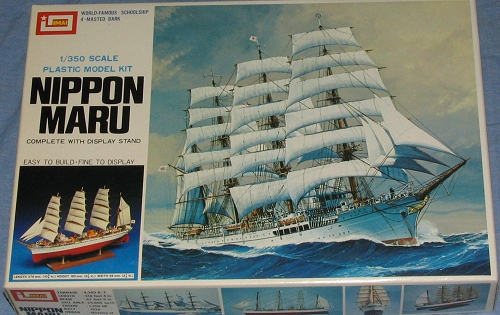
| KIT: | Imai 1/350 Nippon Maru |
| KIT #: | B-704 |
| PRICE: | $9.95 MSRP |
| DECALS: | One option |
| REVIEWER: | Scott Van Aken |
| NOTES: | 1979 boxing |

| HISTORY |
Bark (4m). L/B/D: 307 × 42.5 × 22.5 (93.6m × 13m × 6.9m). Tons: 2,285 grt. Hull: steel. Comp.: 150-200. Mach.: aux. diesel, 2,600 hp. Built: Kawasaki Dockyard Co., Kobe, Japan; 1930.
In the late 1920s, the Japanese Ministry of Transport ordered the four-masted barks Nippon Maru and Kaiwo Maru for the Kokai-Kunrensho (Institute for Nautical Training), which already operated the four-masted bark Taisei Maru and the four-masted barkentine Shintoku Maru. Their work for the merchant marine is reflected in their names. Maru, which signifies wholeness or unity, is an almost universal suffix for Japanese merchant-ship names. Nippon means Japan, and Kaiwo is the mythological king of the seas, equivalent to Neptune or Poseidon. Commissioned in 1930 and 1931, respectively, the barks were described by Harold Underhill as "imposing rather than beautiful." Their very high freeboards reflected a desire to maximize the amount of natural light admitted to the crew spaces below decks, while their comparatively shorter yards and smaller sails were designed to accommodate the relatively small stature of the average Japanese before World War II.
Before World War II, the ships' training voyages carried them throughout the Pacific, and Nippon Maru made four voyages to the United States, five to Hawaii and seven elsewhere in the Pacific. During World War II her yards were sent down and she was used as a motor-training vessel in the Home Islands. Repatriating Japanese soldiers and civilians after the war, she was rerigged in 1952 and resumed training, making her first cruise to the United States in 1954, and her first to the East Coast in 1960. Both Nippon Maru and Kaiwo Maru remained active training ships until the 1980s, when they were replaced by new ships with the same names.
| THE KIT |
 Once the box is opened, one's eyes are assaulted by some of the brightest colors I've seen in a kit in a long time. A large white sprue is mixed in with several smaller ones in orange with a gold plated display stand sprue, red lower hull and two white vacuformed sheets. Also included is a spool of thread for the rigging.
Once the box is opened, one's eyes are assaulted by some of the brightest colors I've seen in a kit in a long time. A large white sprue is mixed in with several smaller ones in orange with a gold plated display stand sprue, red lower hull and two white vacuformed sheets. Also included is a spool of thread for the rigging.
The upper hull/deck is one piece and has a bit of flash on the stern. Test fitting the upper and lower hull pieces shows a bit of a mis-match in that the upper section is wider. However, a brace in the lower half should take care of that. The parts themselves are fairly well formed with what little actual detail there is (such as the deck planking) being the raised variety. Sails are provided on two vacuformed sheets.
Instructions are in English and provide 13 construction steps. Color information is provided where needed in generic names. Many of the steps are given to rigging the model and a complete rigging diagram is provided as well. With four masts, it won't be a snap to build, but it doesn't seem as daunting as first impressions would give. A small flag sheet (not shown) is provided with flags of Japan, the US, and the US Bicentennial. A ship's name and embellishments decal is provided for the stern. In addition to the usual instructions, a full size (as in 1/350) color painting guide is also given. The sides of the box provide some color photos of the actual ship.
| CONCLUSIONS |
Not only is this a pretty neat ship, it is in a standard scale and it is not expensive (at least not when I was able to find a place that sold it on the net). While I wouldn't recommend this one for a beginner, those with some experience with full-rigged ships should not have any trouble with it at all.
June 2005
| REFERENCES |
Review kit courtesy of my luck at raffles!
If you would like your product reviewed fairly and quickly by asite that has nearly 300,000 visitors a month, please contactme or see other details in the